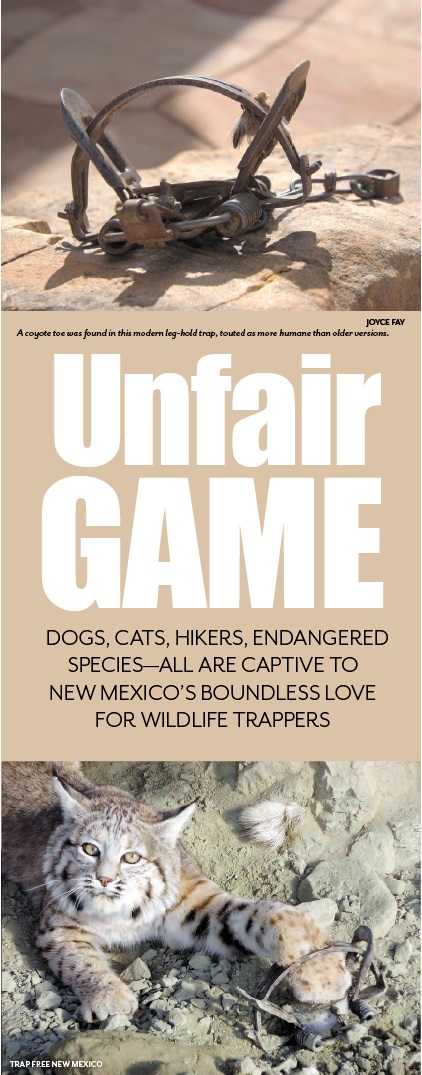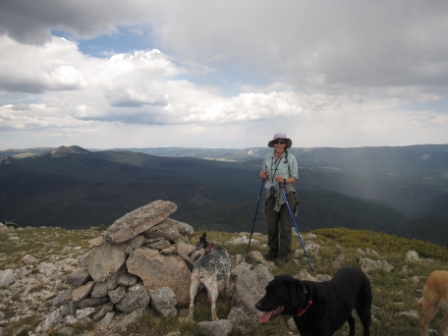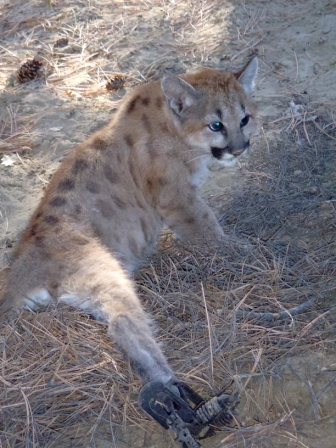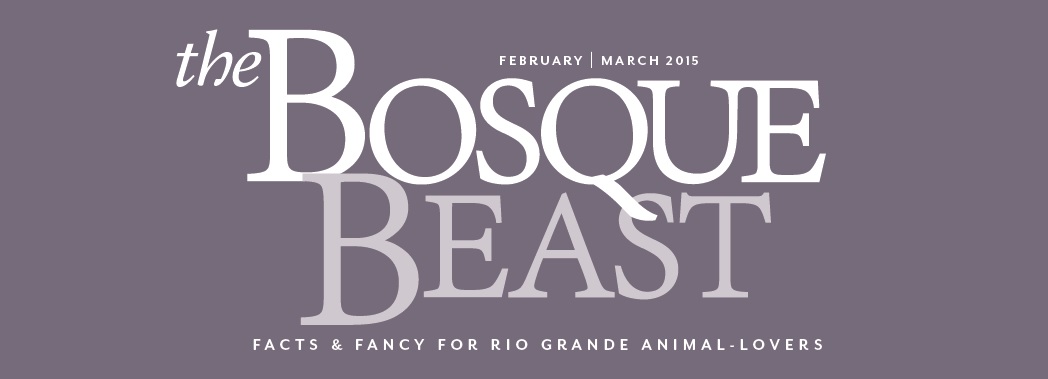
THE MOST STRIKING THING in stories about dogs caught in wildlife traps is the similarity of their humans’ reactions. Man or woman, rural or urban, their dog’s unearthly screams are a sound many say they will never forget—along with getting bitten while trying to free their animals. Many dogs have lost legs in traps; cats often fare worse because it takes so long for them to be found. Over the last ten years, fur trapping—which many people think of as a relic from the 1800s—has grown into a contentious issue on public lands in a state that does not limit how many traps can be set.
Bobcat is the most lucrative catch. Until about ten years ago, a pelt might fetch $80, according to Trap Free New Mexico spokeswoman Mary Katherine Ray. Today, depending on how thick and spotted the fur, a pelt might bring $800 to $2,000 at auction. Thanks to demand in China and Russia, even fox and coyote can fetch $20 to $40 to be used for trim, Ray said. While prices dipped a little during the recession, interest in trapping has not.
In New Mexico, thousands of traps lurk a short distance from National Forest, BLM, and state trails, many in popular hiking areas like the Gila and Lincoln national forests. Every year, more than 2,000 bobcats are trapped, according to New Mexico Department of Game & Fish data. Bobcat is the only “harvest” that is accurately known, since the pelts must be tagged to certify that they are not from an endangered species. What is not known is how many bobcats remain in the wild, since Game & Fish does not track the furbearer population, and all wildlife suffered heavy losses from wildfires in the last few years.
Trappers are not required to report any “non-target” animals they catch, and no agency counts the number of pets killed or injured. But casual lists like the one kept by Trap Free New Mexico, or the national group Born Free USA, send a chilling message to anyone who runs their dogs outdoors. So many pets have been mangled in traps that a number of hunting and outdoor groups have created YouTube videos showing how to free your dog, since many hikers are unable to do so alone. Studies have found that non-target animals make up two-thirds to three-quarters of the typical trapper’s catch.

Even in urban areas,
pets and people are not immune. In November 2013, a dog walked into a
trap off the Embudo Trail in the Sandia, just a quarter mile from the
trailhead at Indian School. The trapper claimed the popular trail
extension was exempt from the 25-yard buffer zone. Hikers have
encountered traps in Placitas, in Eldorado, and across Santa Fe and Taos
counties. In February 2013, a kitten lost part of a paw in an illegal
trap set near Rio Grande and Indian School roads.
For Mary Katherine Ray, two encounters with traps—including the
traumatic experience of finding a coyote in one on a Sierra Club
hike—transformed her politically. “The thought that someone could do
that to someone else changed my life,” she said of how it ended the
peaceful refuge she took in the outdoors.
Many people report being badly shaken by traps, even if their dog
escaped with life and limbs. Terry DuBois and the rest of the Mountain
Canine Corps practice search-and-rescue with their dogs in Los Alamos
County twice a week. Last January, her 12-year-old Heeler started
shrieking on a well-established trail on Forest Service land. Luckily,
one of her friends had seen the video on how to open a trap, and Jetta
escaped with a limp. But the experience led DuBois and others on the
corps—including another who had a dog trapped—to fight for a ban, which
they successfully passed in Los Alamos County last April.
At the state level, trapping is protected by the political might of
ranching and hunting groups. Though many hunters oppose hunting on
humane grounds, says Ray, “the hunting groups seem to feel like it might
be a slippery slope to banning hunting in general”— though nothing of
the kind has happened in Arizona or Colorado, which banned trapping in
the mid-1990s.

Hunters, in fact, register a strong presence on Trap Free New Mexico’s
list of victims with stories to tell, since they often range across
public lands with their dogs. Several recount coming across wild animals
caught in traps and shooting them to end their suffering, including one
who found an endangered species of rabbit that had nearly torn off both
paws. “I have to say it was the most satisfying thing I’ve done all
week,” the hunter wrote about shooting the rabbit and hurling the trap
down a mine shaft. “As a hunter myself, I find trappers and trapping
unconscionable.”
Last year, 1,831 people bought furbearer licenses in New Mexico, of
which maybe a quarter used them to hunt the target animals, according to
Ray. These include beaver, muskrat, fox, badger, raccoon, and bobcat,
whose seasons run anywhere from November to May. That leaves about 1,300
to 1,500 “fur harvesters” who use the license to trap. Since coyote and
skunk can be trapped anytime, traps are abundant year round.
Trappers are supposed to report to Game & Fish the target animals
they kill, but it’s nearly impossible to know if they do. Most set two
or three dozen traps, but some set hundreds. By law, traps must remain
25 yards from hiking trails and public roads, be marked with the
trapper’s identity, and be checked every 24 hours. In practice, traps
are rarely checked more than every few days, as trappers prefer to wait
until their catch has died of thirst, infection, gangrene, or predation.
“I feel like a prisoner in my own home” writes one hiker who lives in
Socorro County of a trapper who had taken over a nearby canyon. “It
takes him 6 hours to check all his traps—there must be hundreds of them
and he has been here for weeks already. It will probably be years before
I see a bobcat again.”
In searching the dozens of reports about pets being caught in traps,
we could not find a single case where the agency penalized a trapper for
violations. In fact, game wardens often failed to appear when called.
We were also not able to find a single case where the agency returned a
reporter’s call— including ours.
“They feel they can do what they want to do, and don’t have to answer
to the general public,” said Ray, adding that the situation had grown
worse under Gov. Susana Martinez.

This widespread perception that Game & Fish serves livestock and
hunting interests alone feeds the frustration of outdoor enthusiasts who
say a small minority is allowed to exploit a public resource to the
detriment and danger of everyone else. Trappers pay $20 for a license,
and are allowed to take and sell whatever they catch on public lands.
“The Game Commission is so slanted against us,” said Terry DuBois,
“and you’re not getting lay people on that board. If you look at the
people on Game & Fish, they’ve all been appointed by our governor,
and most of them represent ranching, hunting, and gun-type industries.”
In fact, the Game Commission—an appointed body that oversees the Game
& Fish department—has faced embarrassing accusations against its top
officials in recent years. Game Commission chairman Scott Bidegain
stepped down a year ago after reports of illegal cougar hunting on his
ranch, after he won a prize in a coyote-killing contest. In 2013, agency
director Jim Lane— known for his pro-hunting, anti-conservation
stance—resigned abruptly with the unanimous approval of the Game
Commission. In 2008, director Bruce Thompson resigned over allegations
of an illegal deer hunt. Meantime, the state’s population of black bear
and cougar appear to have fallen to dangerously low levels that are not
being monitored.
Once again this year, Rep. Bobby Gonzales of Taos will introduce a
bill at the state Legislature banning trapping on public lands. His last
attempt in 2013 died in committee in a vote mostly along party lines.
“Why individuals voted against it, I can’t answer for them,” Gonzales
said, adding that ranchers tend to support trapping because they see the
target animals as a nuisance.
Gonzales says he has constituents who have had dogs injured in traps,
and opposes the practice because it is cruel. “It’s a very antiquated
way of trying to catch animals,” he said. “And the suffering— you’d
think today you’d have more understanding.” He said he saw such an
outpouring of support after his 2013 bill, he is certain that a ban
would pass if the issue were put to voters. That option is not
available to New Mexicans, however, as it was in Arizona and Colorado.
According to a 2005 poll by Research and Polling Inc., 63 percent of
New Mexico voters support a ban on leghold, snare, and lethal traps on
public lands. In 2011, more than 12,000 comments were submitted to Game
& Fish advocating a ban, after the Game Commission voted unanimously
to lift a temporary ban on trapping in the Mexican Gray Wolf Recovery
area. Some 14 endangered Mexican Gray Wolves (out of a population of 50
at the time) had been trapped, several of them requiring amputation.
Incensed that the agency had ignored public sentiment, a coalition of
conservation and animal advocacy groups held a People’s Forum Panel on
the issue in September 2011, and reported that 90 percent of comments it
received ran in favor of a ban.
Of course, trappers are unlikely to comment on such an issue, being
well aware of public sentiment. We reached out to Tom McDowell,
president of the New Mexico Trappers Association (NMTA), but he was out
of cell-phone range for at least a week on a trapping expedition,
“helping a rancher,” according to his family.
Terry DuBois confirmed that those who oppose a ban are concerned not
only with protecting the income that comes from an occasional bobcat
catch. “They feel like trapping is a constitutional right, and having it
taken away is a violation of their rights and privileges as American
citizens,” she said. “They feel like the animals are theirs for the
taking, and it’s their right to do with them as they please.”
The state of New Mexico, based on all available evidence, agrees with them.
For more information
Trap Free New Mexico: www.trapfreenm.org
People’s Forum Panel on New Mexico
Public Lands Trapping:
www.nmtrappingforumpanel.org
Born Free USA: www.bornfreeusa.org
